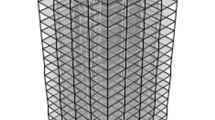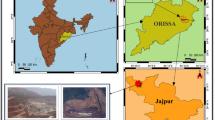Abstract
The article presents the results from a study of dynamic characteristics of the response of a high-rise building under the seismic impact of a series of southern Baikal earthquakes in 2007–2008. One earthquake used in the study, the Kultuk, occurred on August 27, 2008, at 10:35 LT (UTC +8). The epicenter of tremors was at the bottom of Lake Baikal, 30 km from Baikalsk, 75 km south of Irkutsk. The data were obtained by an engineering seismometric station installed on a large-panel nine-story building of the 135 series. The station consists of a 16-channel 24-bit digital-to-analog converter, 5 OSP-2M two-component accelerometers installed in the basement and on the third, fifth, seventh, and ninth floors of the building, and two SK-1P seismic sensors installed in the basement and on the ninth floor. The paper compares the peak ground acceleration values at the levels of the basement and ninth floor. The relative amplification of the acceleration amplitudes of the ninth floor with respect to the base are obtained, while it is noted that the time references of peak ground accelerations do not correlate with each other. Further study of the vibration acceleration waveforms using wavelet analysis showed that the energy of forced vibrations of the building under seismic action is redistributed from higher frequencies towards low-frequency range, close to the eigenfrequencies of the building vibrations. Based on the obtained vibration spectrograms, the frequency–amplitude gains of the building’s response to seismic events were calculated for various altitude levels. The maximum gain for the ninth floor is 17 units at the eigenfrequency of the building.






Similar content being viewed by others
REFERENCES
Bazarov, A.D. and Surzhikov, A.P., Development of hardware-software complex for the dynamic characteristics of engineering strucutres control, Kontrol’. Diagn., 2014, no. 11, pp. 57–61. https://doi.org/10.14489/td.2014.011.pp.057-061
Çelebi, M., Recorded earthquake responsses from the integrated seismic monitoring network of the Atwood Building, Anchorage, Alaska, Earthquake Spectra, 2006, vol. 22, no. 4, pp. 847–864. https://doi.org/10.1193/1.2359702
Chandramohan, R., Ma, Q., Wotherspoon, L.M., Bradley, B.A., Nayyerloo, M., Uma, S.R., and Stephens, M.T., Response of instrumented buildings under the 2016 Kaikoura earthquake, Bull. N. Z. Soc. Earthquake Eng., 2016, vol. 50, no. 2, pp. 237–252. https://doi.org/10.5459/bnzsee.50.2.237-252
Emanov, A.F., Bakh, A.A., and Kletsin, V.I., Standing waves in the dam of the Boguchan and Chirkean hydroelectric power station, Prir. Tekhnog. Riski. Bezop. Sooruzh., 2018, no. 4, pp. 28–33.
Khachiyan, E.Ye., On the character of structure vibrations during earthquakes, Seismostoikoe Stroit. Bezop. Sooruzh., 2010, no. 6, pp. 15–18.
Melnikova, V.I., Gileva, N.A., Arefyev, S.S., Bykova, V.V., and Seredkina, A.I., The August 27, 2008, M w = 6.3 Kultuk earthquake (South Baikal): The stress-strain state of the source area from the aftershock data, Izv., Phys. Solid Earth, 2013, vol. 49, no. 4, pp. 563–576. https://doi.org/10.1134/S1069351313040071
Pavlenov, V.A., Chechel’nitskii, V.V., Chernykh, E.N., Rashutina, N.V., Semibalamut, V.M., and Rybushkin, A.Yu., Recovery of engineering and seismic agency in Irkutsk, Problemy otsenki i prognoza ustoichivosti geologicheskoi sredy g. Irkutska (Problems of Estimating and Predicting Sustainability of Geological Environment of Irkutsk), Lobatskaya, R.M., Ed., Irkutsk: Irkutsk Natl. Research Tech. Univ., 1997, pp. 86–91.
Saburov, V.S. and Kuz’menko, A.P., Obsledovanie zdanii povyshennoi etazhnosti. Inzhenerno-seismometricheskii metod (Inspection of High-Rise Buildings: Engineering and Seismic Measurement Approach) Lambert, 2013.
Shestakov, O.V. and Zakharova, T.V., Veivlet-analiz i ego prilozheniya (Wavelet Analysis and Its Applications), Moscow: Infra, 2014.
Tatkov, G.I., Bazarov, A.D., and Berzhinskiy, Ya.A., Estimate of microdynamic measurement efficiency during vibration tests of 1.120 C series riegelousless structures, Seismostoikoe Stroit. Bezop. Sooruzh., 2010, no. 1, pp. 21–27.
Tatkov, G.I., Kalashnikov, M.P., Bazarov, A.D., and Berzhinskaya, L.P., and Demberel, S., Seismic safety of residential development of Ulaanbaatar, Vestnik Vost.-Sibirskii Gos. Univ. Tekhnol. Upr., 2012, no. 1, p. 34.
Zavalishin, S.I., Shablinskii, G.E., Zubkov, D.A., and Rumyantsev, A.A., Dynamical monitoring of buildings and structures for inspection of their seismic safety, Predotvrashchenie avarii zdanii i sooruzhenii. Sb. nauch. tr. (Accident Prevention of Buildings and Structures: Collection of Research Works), Moscow, 2009, vol. 8, pp. 42–53.
Funding
The study was carried out under a state assignment by the Ministry of Science and Higher Education of the Russian Federation (project no. 0152-2019-0012, AAAA-A21-121011890033-1).
Author information
Authors and Affiliations
Corresponding author
Ethics declarations
The authors declare that they have no conflicts of interest.
About this article
Cite this article
Bazarov, A.D., Shagun, A.N. & Tubanov, T.A. Analysis of Recorded Earthquake Responses of a High-Rise Building Based on Engineering Seismometric Observations. Seism. Instr. 58, 55–62 (2022). https://doi.org/10.3103/S0747923922010029
Received:
Revised:
Accepted:
Published:
Issue Date:
DOI: https://doi.org/10.3103/S0747923922010029




